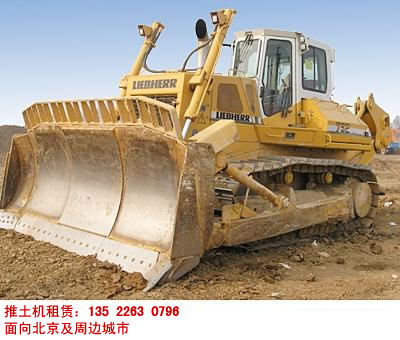Beijing bulldozer rental: 135 226 30796
Contact us: Mr. Liu 135 226 30796 (If you encounter a busy signal, please try again)
Beijing bulldozer rental, based in Beijing, providing bulldozer rental services to surrounding provinces.
--------------------------------------------------------------------------------
Correct operation of tracked bulldozer driving (Author: Xu Yongjie, Sun Shuxian), strict operation.
1. Gear shifting and forward/reverse movement
When shifting gears, first push the throttle lever forward to the low-speed idle position, then push the main clutch lever all the way forward to disengage the main clutch. Due to the action of the small brake inside the main clutch, the power input shaft of the transmission stops rotating. At this point, the gearshift lever can be accurately moved to the desired gear, and the forward/reverse lever can be placed in the forward or reverse position (when the bulldozer moves forward, pull the forward/reverse lever backward; when moving backward, push it forward). After shifting, pull the throttle lever back to increase the engine speed and smoothly engage the main clutch, starting the bulldozer's movement.
When the bulldozer is in motion, the main clutch control rod should be pulled all the way back and not left in a semi-engaged position. A semi-engaged main clutch will accelerate the wear of the friction plates.
The bulldozer's transmission generally has five forward gears and four reverse gears. The direction of travel can be changed using the forward/reverse lever.
During operations, the bulldozer should run at its highest possible speed to improve efficiency. However, the driver must always monitor the engine's operation. If the engine overheats or black smoke appears in the exhaust, reduce the speed appropriately.
2. Steering
To turn while moving, pull the steering clutch lever on the side you wish to turn towards the rear to disengage the steering clutch. This slows the corresponding track, causing the bulldozer to start turning. For sharp turns, in addition to disengaging the steering clutch, press the corresponding brake pedal. Sharp turns are generally only allowed in first gear. When not using the brakes, keep your foot off the brake pedal to avoid unnecessary wear on the brake bands and increased fuel consumption.
When steering, press the brake pedal smoothly to prevent bouncing during turns. After completing the turn, release the brake pedal first, then release the control lever. If the turning radius is large, there is no need to press the brake pedal. Avoid making high-speed on-the-spot turns unless necessary, as this could cause the tracks to derail and lead to accidents.
3. Driving on slopes
Different models of bulldozers have different climbing capabilities (usually up to 30°). The slope and terrain that bulldozers of the same construction can adapt to also vary. Drivers should be familiar with the climbing limits of the model they are using to avoid sliding due to insufficient uphill or downhill capability.
Before going uphill, select an appropriate gear based on the terrain, slope size, and length. Do not shift gears mid-climb. While climbing, the bulldozer should operate perpendicular to the hillside horizontally. Do not drive across steep slopes; lower the blade appropriately to avoid obstructing the view and ensure it can quickly touch the ground in case of a slide to help stop the bulldozer. If the engine stalls mid-climb, immediately stop fuel supply, lower the blade, and apply emergency braking. If it is not possible to stop on the slope, switch to reverse and slowly slide to the bottom (braking while sliding), then restart the engine. If fuel supply is not stopped and the bulldozer slides down in forward gear, reverse power transmission to the engine may cause a fire and oil spraying from the air filter. In case of a fire, quickly close the throttle and apply the brakes. Before restarting, check if the gearshift lever is in neutral.
When descending a slope, use low gear with minimal throttle and apply the brake pedal.
4. Crossing cliffs or rocky areas
When the bulldozer needs to cross large soil mounds or cliff edges, approach slowly at low speed. As the top is reached and the body begins to tilt forward, quickly disengage the clutch to allow the front of the bulldozer to gently touch the ground, then re-engage the clutch to continue moving forward. Do not cross obstacles diagonally, and do not operate the steering lever while crossing.
When crossing rocky areas, plan the route in advance and drive straight through, minimizing turns. Use low gear with minimal throttle, and avoid high gear with large throttle while navigating bumpy rocky areas and making sharp turns.
5. Self-rescue when stuck
When operating a bulldozer in areas with extremely high water content or muddy areas after rain, the bulldozer is prone to getting stuck. There are two self-rescue methods for such situations:
(1) If the bulldozer gets slightly stuck while pushing dirt forward on flat ground, manipulate the bulldozer control lever to use the hydraulic blade to lift the front of the machine, pressing the rear down. Then manipulate the bulldozer control lever to raise the hydraulic blade, lowering the front and repositioning the rear (this process can be repeated multiple times depending on the stuck area). Then put the bulldozer in reverse gear I, appropriately increase the throttle, engage the main clutch, and reverse a short distance (usually about 5-10 cm each time). Immediately step on the brake pedal and disengage the main clutch control lever. Repeating this process multiple times will successfully free the stuck bulldozer.
(2) If the above method does not work to free the stuck bulldozer, fix one end of a steel rope to a tree or stake, and secure the other end to one or both sides of the bulldozer’s tracks (if only one track is stuck, secure the rope to the stuck track; if both tracks are deeply stuck, use two ropes fixed to both tracks). Then start the engine, engage reverse gear I (or forward gear I), and slowly rotate the tracks, wrapping the steel rope around them to drag the bulldozer out. (end)




